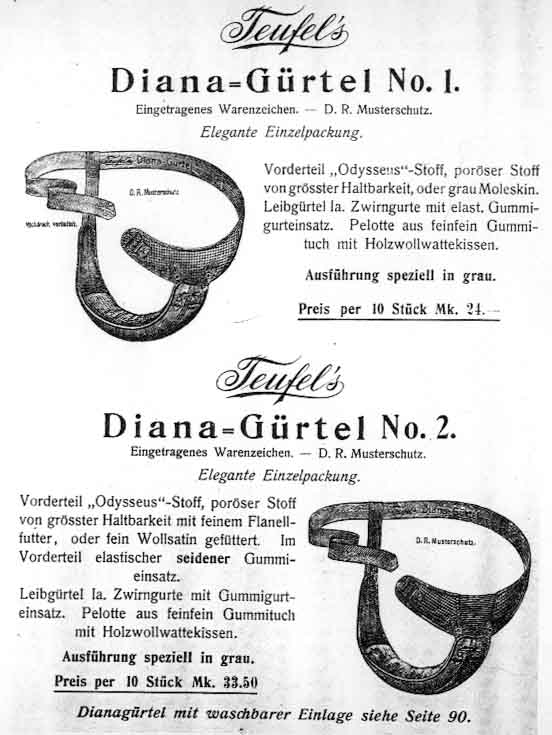See Japanese instructions
for making menstrual belts and pads at home in
the early 20th century.
Suspenders
to hold pads (U.S.A., 19th century)
More belt topics
Actual belts in the
museum
See how women wore
a belt (and in a Swedish ad) - many actual 20th-century
belts - a modern
belt for a washable pad and a page from
the 1946-47 Sears
catalog showing a great variety - ad for
Hickory belts,
1920s? - Modess belts
in Personal Digest (1966) - drawing for a
proposed German belt
and pad, 1894
See Japanese instructions
for making menstrual belts and pads at home in
the early 20th century.
See a prototype of
the first Kotex ad.
See more Kotex items: Ad 1928 (Sears and Roebuck catalog)
- Marjorie May's Twelfth
Birthday (booklet for girls, 1928,
Australian edition; there are many links here to
Kotex items) - 1920s booklet in Spanish showing
disposal method -
box from about 1969 -
Preparing
for Womanhood (1920s, booklet for girls)
- "Are you in the know?"
ads (Kotex) (1949)(1953)(1964)(booklet, 1956) - See
more ads on the Ads for
Teenagers main page


|

Ad for washable-pad belts
("Diana-Gürtel"), from Teufel
(Germany, ca. 1900?)
Teufel (devil
in German, here certainly a family
name - um, right?) also made a line of
washable pads.
Commercial belts for menstrual pads
probably appeared in the 19th century
(see an American
one and a later one from Japan, which
shows a curious rebounding European
influence; and see many that this
museum has)
Diana, of course, is the Roman
goddess of the hunt, moon and virgins,
and her name here betrays the much
higher awareness of the public then
for classical themes (the American
company Sears, Roebuck & Co. sold
Diana and Venus
menstrual belts).
Classical, too, is Odysseus - Ulysses - the
brand-name material used in the front
part of the belt, below, and - Whoa! How did he get
in there?! He didn't have to leave
the house for this adventure! Classical
hanky-panky in the German menstrual
products industry! And perhaps rightly
so that the Devil is involved!
The ad is from Junker, Almut and
Stille, Eva.: Zur Geschichte der
Unterwäsche [Towards
a History of Underwear].
1700-1960. Eine Ausstellung des
Historischen Museums Frankfurt 28.
April bis 28. August 1988. ; FfM,
Germany (Historisches Museum) 1988, the catalog
of an exhibit of the history of
underwear at the museum of the city of
Frankfurt am Main, Germany.
Unfortunately the catalog does not
tell where the ad appeared; it strikes
me as being from the manufacturer's
own catalog; see the last sentence of
the ad on this page, which suggests
that there are many pages of Teufel's
things in this publication (Teuflisch schwer! -
Devilishly
difficult, this problem!)
My translation
lies below the ad.
|
|

|
Translation
for the first belt:
Diana
Belt No. 1
Registered trademark -
Patent of the German
Empire [D. R.
means Deutsches Reich, the
second one, which lasted
from 1871 until the end of
World War I; the first one
started with Charlemagne (
962 A. D.), and Napoleon
ended it in 1806; and the
third began and ended with,
yes, Hitler.]
Elegant
individual packaging
Front part made from
"Odysseus" (Ulysses)
material, porous material
of the greatest
durability, or gray
moleskin.
Waist belt of knitted
webbing with rubber
insert.
Suspended pouch made from
super-fine [feinfein,
no less!] rubberized
fabric with a pad of
tiny
wood shavings [And
you think you
have it bad?]
The
second belt has better
material and is pricier.
The
sentence at the bottom
translates as
Diana
belts with washable
inserts, see page 90.
which hints that this page
is from the Teufel
products catalog. See some
Diana
washable pads.
You can see which part of
the belt goes in front with
your MUM's handy-dandy
diagram, which
explains all for the
uninitiated, meaning men,
usually. Hey, it took me a
long time to figure this
out.
Belts
and washable pads from the
1902
and 1908 Sears, Roebuck
catalogs - belt from Jordan,
Marsh & Co. catalog,
Boston, 1891. Suspenders
to hold pads (U.S.A., 19th
century)
© 2001 Harry
Finley. It is
illegal to
reproduce or
distribute work on
this Web site in
any manner or
medium without
written permission
of the author.
Please report
suspected
violations to hfinley@mum.org
|
|
|
|